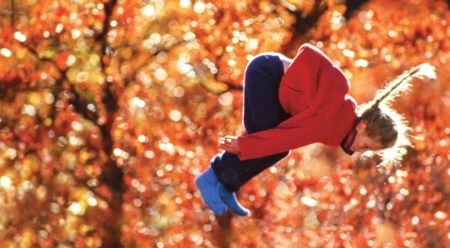The Reward Of Risk: Building Confidence In Kids
Patagonia has offered corporate-sponsored on-site child care since 1983. The Great Pacific Child Development Center, GPCDC for short, is where infants and children spend their days crawling, running, climbing and exploring, mostly outdoors, while their parents work. We wanted to tell the story of GPCDC, so we published Family Business by Malinda Chouinard and Jennifer Ridgeway. The book illustrates what high-quality child care looks like and explains why providing on-site child care to working families is at the heart of responsible business today. The following is another in our series of excerpts from Family Business; it’s Chapter Nine, “Strengthening Bodies.”
Chapter Nine: Strengthening Bodies
Giving infants time, space, and skillful support to develop physically is crucial. As babies learn to move, they discover that they can affect themselves, objects, and other people. Each new skill—rolling over, sitting up, or crawling—lays the foundation for all areas of life: physically, mentally, and even socially. Respecting developmental stages is critical, so we never force infants to sit up or walk before they are ready to do so on their own, and we don’t use walkers, jumpers, “activity” seats, or high chairs. Our teachers carefully track important physical milestones, because solid development of the body is the sound groundwork for life.
“Trust your baby’s competence: She wants to do things for herself, and she can do things for herself.”
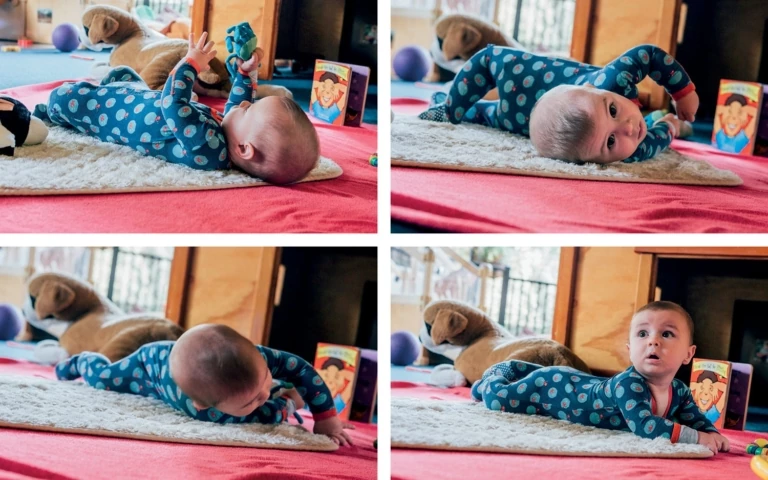
Photos: Kyle Sparks
Floor time allows infants to gain control of their bodies.
During floor time, babies are placed on their backs and have uninterrupted time to move how they like. Infants reach, roll, and push up, all the while building confidence and autonomy. One of the first things infants learn to do is put their fingers and toes into their mouths. Caregivers arrange interesting selections of objects and toys on the floor, knowing that infants, eager explorers, will initiate movement in the direction of them. When they can roll to get what they desire, they have a greater sense of power and will. Magda Gerber had the right idea: “Instead of trying to teach babies new skills, we appreciate and admire what babies are actually doing.” In the photos above, a five-month-old works hard to maneuver from his back to his stomach. He reaches across his body, then kicks his opposing leg over and lets gravity do the rest. While infants move, caregivers provide encouragement by saying, for example, “I see that you are becoming frustrated trying to roll over. You almost have it—just get that leg over and you’ll be on your tummy. I’m right here for you.”

Photo: Kyle Sparks
Trust babies to learn to push up and pivot to sit in their own time.
Babies begin to roll onto their stomachs on their own, around the same time their arm, neck, and back muscles are strong enough to push up. This action begins the lifelong action of extending the spine upward, which will be needed for crawling and eventually standing. A few months later, these children use problem-solving skills and developing muscles to pivot into a sitting position. From all fours, infants rock back so that their legs are underneath them with their hands still on the floor. Once ready, they will pick up their hands and figure out where to place their legs for greater stability.
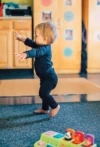
Photo: Kyle Sparks
Learning to walk takes patience and time.
Walking, and ultimately running, takes practice and patience as children learn to balance in many positions and coordinate their movements. When children first walk, their gait is unsteady and arms are held wide for added balance. As skills are refined, children draw their arms in, move more intentionally, and seldom fall. On two feet, children feel triumphant, moving the way they’ve seen others do. For the first time, their hands are free while they move. On-site child care has many benefits, including being able to see baby’s first steps. If possible, caregivers contact parents so they can be there for their children’s major milestones.

Photo: Kyle Sparks
Balance combines physical control, vision, and body awareness.
Balance, the foundation of movement, is comprised of three elements: physical control, vision, and the awareness of the body in space (proprioception). The three systems develop slowly and in tandem. Children first learn to balance their head, then their trunk, and finally to incorporate their feet and legs. As they grow, kids rely more and more on their sense of balance, attempting increasingly daring feats; their success determined by the abilities they built as babies.

Photo: Kyle Sparks
We help children learn to balance risk and safety.
Our environment and program encourage risk taking. The materials offer a range of challenges, so that children can incrementally increase risk. We offer classes like gymnastics, which promotes balance, flexibility, and controlled risk. Our older children take to the nearby bike path with skateboards, scooters, and roller skates. Teachers talk with children about their strategies for new maneuvers, helping them to assess risk. Children will do what they can do, when they can do it.
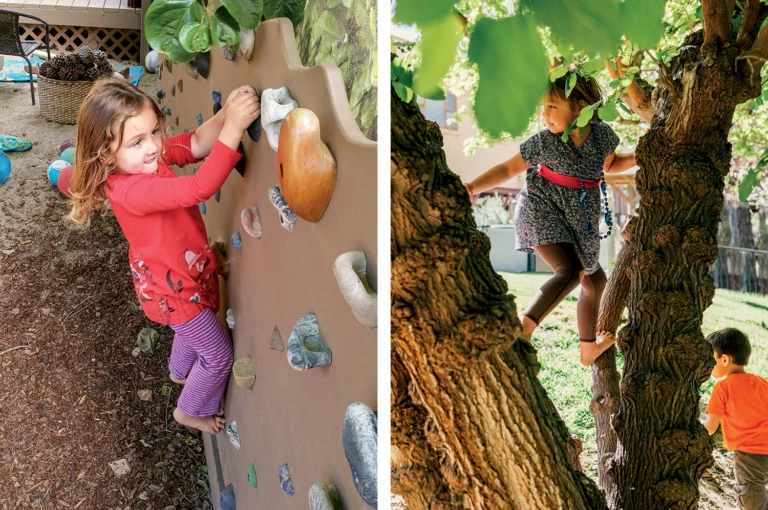
Photos: Kyle Sparks
We let young children take risks by climbing.
Climbing is driven by children’s inborn desire to explore. Just as rolling over, sitting up, and pulling to stand have their own challenges and rewards, climbing provides a new perspective on the world and requires control and hand-eye coordination. Kids develop movement skills naturally as they play. When preschoolers climb, they practice bilateral integration, hand-eye coordination, muscular strength, and endurance. Respecting children means encouraging them to explore their capabilities. Safety is always foremost, but we do restrain ourselves from prematurely rescuing them, providing just a little assistance if truly necessary. Patagonia’s roots are in climbing and in the mountains. It’s in our DNA to watch our kids get an early start climbing.
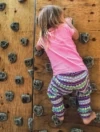
Photo: Kyle Sparks
Help children–especially girls–face their fears and complete tasks.
We are failing our girls. Parents are four times as likely to tell girls than boys to be careful (according to a 2015 study in The Journal of Pediatric Psychology). Girls are warned away from activities that hint of risk. Parents are more likely to assist their sons to face their fears with instructions on how to complete the task on their own. We need to teach both boys and girls the skills they need to be confident, responsible problem solvers and risk takers.
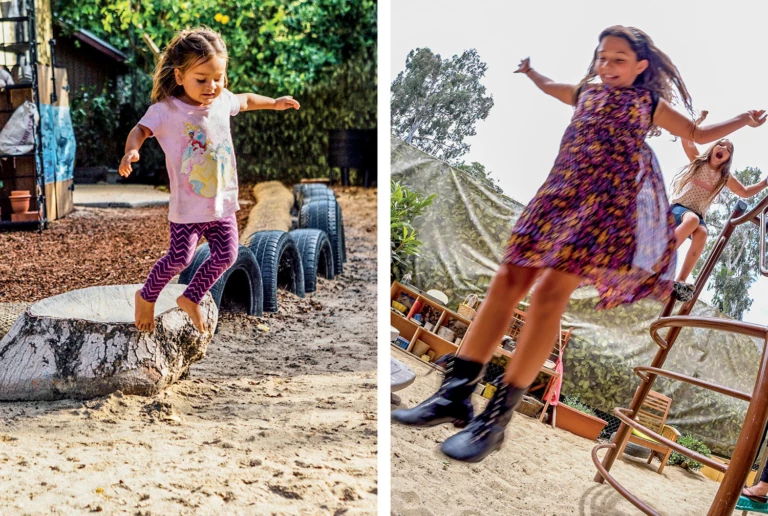
Photos: Kyle Sparks
Jumping requires courage, leg strength, and an understanding of gravity.
Young children may choose to jump into the arms of a trusted caregiver before tackling the task alone. If a child feels confident enough to attempt a risky jump, we let them. Teachers stand by and give encouragement, offering physical assistance only if the situation becomes dangerous. We do not rescue children. When a child climbs with the intention of jumping, then decides it’s not right, our teachers coach them by saying: “You’ve climbed high. Do you want to jump down? If you don’t, I will help you figure out how to climb down.”

Photo: Kyle Sparks
Mastering wheels is an important physical milestone.
Using scooters, pushcarts, tricycles, and bicycles are opportunities for problem solving and gives children practice with whole-body coordination—plus they can go on road trips with friends. In the photo above, our Kids’ Club children take their bikes out for a self-powered field trip to the outskirts of town. Learning to ride a bicycle begins when toddlers practice maneuvering on and off. Eventually, they discover how to scoot their feet, then off they go. Learning to steer, stop, and avoid traffic jams lasts a lifetime. We respect children’s desire to learn in their own way and in their own time. If they want to spend all day getting on and off a scooter or sit all afternoon, motionless, on a tandem tricycle with a friend, that’s fine.

Family Business: 30 Years of Innovative On-site Child Care, by Malinda Chouinard and Jennifer Ridgeway
Learn more about the Family Business project, watch a series of videos about working families and buy the book at patagonia.com.
